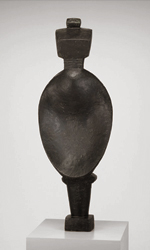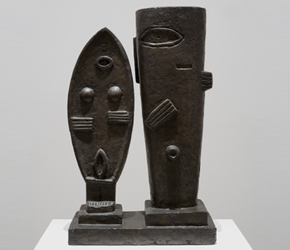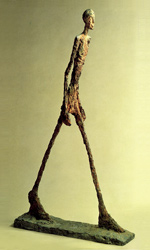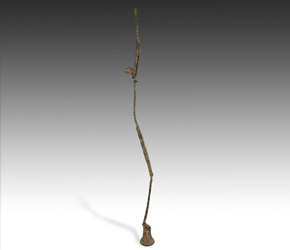The Chicken or the Egg – Giacometti and Dogon Art
PRIMITIVE - Thursday, October 13, 2016By Glen Joffe
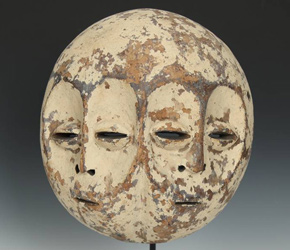 |
|
Globalization – the term describing free trade, cultural integration, vanishing borders and accessible communication throughout the world – is surprisingly modern. Coined in 1983 by Theodore Levitt, a marketing professor at the Harvard Business School, it considers the exponential influence of advancements in technology and the expansion of the internet. It’s hard to believe the word is only 33 years old; yet globalization began long before the dictionary brought it to light. Scholars have argued human migration to all five continents was the beginning of the ‘one world’ concept. Historical evidence like the rise of early empires and the establishment of the Silk Road suggest globalization is not really a new concept; and while the spread of politics and trade is intriguing, the early effects of globalization can most clearly be seen in the arts.
The influence of artistic styles from one area of the world to another is evident all the way back to ancient times. For example, Chinese jade carvings from the 3rd and 4th century BCE feature Scythian motifs from central Eurasian nomads. Hellenistic styles of the Romans can also be seen in Indian and Han Chinese artworks. In turn, the influence of numerous Buddhist and Chinese motifs can be seen in a myriad of European artworks. Cultural and artistic exchanges in Africa began with Muslim merchants and missionaries from the Arab world and were further accelerated by European expeditions in the 15th century. Exchanges went both ways. Just as African art was influenced by European aesthetics, so too was European art influenced by African “primitivism.” This was especially evident when it came to prominent Modernist artists such as Picasso, Matisse and Brancusi in the early 20th century.
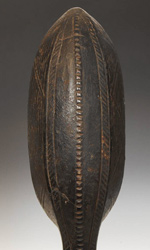 |
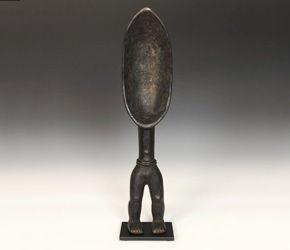 |
|
Alberto Giacometti (1901-1966) is another prominent artist of the 20th century who was influenced by African art. By the late 1920s when Giacometti’s interest was piqued, African art had already been elevated from objects of curiosity to artworks of considerable value and historical significance. Nevertheless, his discovery and incorporation of highly stylized African sculptures allowed him to break free from the shadows of his more famous contemporaries. One of his early works, "Spoon Woman," reveals a mix of cubism and abstraction combined with the form of ceremonial spoons that celebrate the generosity of women among the Dan people of Liberia. Another one of his works, titled "The Couple," likewise features tribal scarification marks and may have been influenced by the Dogon people of Mali who traditionally carved seated figures of couples.
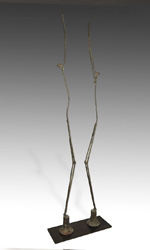 |
|
Giacometti’s interest and engagement with Dogon art was likely a result of his friendship with Michel Leiris, a French surrealist writer and ethnographer. Leiris served as a secretary and archivist in a famous French anthropological expedition into Africa called Dakar-Djibouti, led by Marcel Griaule between 1931 and 1933. The Dogon people living along the Bandiagara Escarpment, a remote 150 kilometer long cliff in Mali were among the ethnic tribes they encountered. The fateful meeting would influence both men for the rest of their lives. Griaule later returned and lived among the Dogon for over 15 years and became the leading source of knowledge in the West concerning the ethnic group. Leiris published numerous books about his experiences during the expedition and maintained a lifelong connection to Africa as an ethnographic writer.
There is little wonder why Griaule, Leiris and Giacometti were interested in the Dogon people and their art. A highly resilient culture, the Dogon resisted Islamization by moving to the cliff a thousand years before. They stayed true to their religion and customs, which were passed down through oral traditions generation after generation. Griaule discovered that the Dogon possessed their own system of astronomical and calendrical measurements, which were intricately connected to the basis of their religion. Much of Dogon religious activities revolved around the worship of the Nommo, usually regarded as mythological ancestral spirits. Created by the sky god, Amma, the Dogon believed the Nommo originally inhabited an invisible world hidden behind the brightest star in the night sky – Sirius, the “Dog Star.” The Dogon promulgated this belief for many centuries, much to the disbelief of ethnographers, anthropologists and even scientists until modern astronomers in fact discovered the existence of a star system hidden behind Sirius in the exact position the Dogon predicted. The Dogon creation myth, coupled with the sacredness of duality, twinness and androgyny form the foundation for a great deal of Dogon art. Much of this work is created by blacksmiths who hold esteemed status as artisans and spiritually empowered individuals.
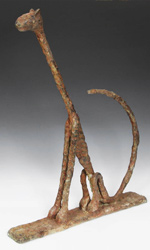 |
|
As Giacometti delved into surrealism and existentialism in the years leading up to and after World War II, his sculptures of people grew thinner, elongated and at times disproportioned. At first they were as small as the size of a cigarette pack and eventually grew over the years until the largest was bigger than the height of an average person. Appearing emaciated, desolate and forlorn, the statues reflected the misery of war-torn Europe; yet the disproportion, abstraction and paring down of the human figure to its barest essence also resembled in many ways the art of Africa, and in particular, the art produced by the Dogon. Whether Giacometti was aware of it or not, his sculptures had the affect of furthering an interest in the aesthetics of African art.
Collectors of Dogon art may have come across works that appear strikingly similar to Giacometti’s signature sculptures with long thin limbs and elongated bodies. Known as Star Gazers, these sculptures have the same feeling as Giacometti’s works, except they are articulated differently as they are always gazing up at the sky, sometimes with their arms raised. These postures have been interpreted as gazing and reaching toward heaven, the place where their ancestors are believed to reside alongside the Nommo. All this begs the question: were these figures inspired by Giacometti’s works? There’s little doubt that Giacometti was influenced by Dogon art, but could the opposite also be true? If so, the question becomes “who influenced who first?” The answer may boil down to the riddle, which came first, the chicken or the egg? In fact, the answer may not even matter. The 20th century was a time when the globalization of art dramatically accelerated and the mutual influence of Dogon artisans and Giacometti on each other was only natural. Their art was simply an extension of the ‘one world’ concept, evidence that borders are only lines on a map and ideas do not need a passport to travel freely.
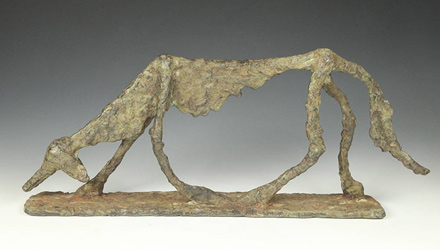 |
